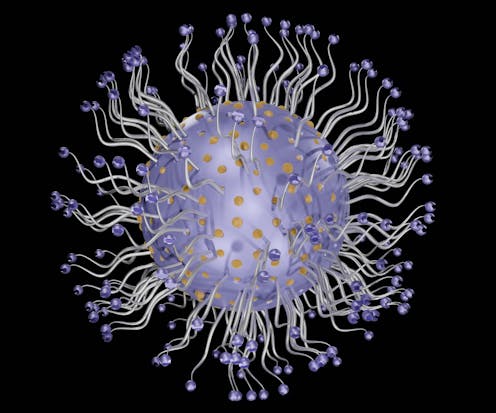
Tiny nanoparticles are at the forefront of materials science – with special properties that make them great at absorbing light in solar panels, cleaning wastewater, and delivering drugs precisely.
Some nanoparticles take the form of sheets or fibres. But nanomaterials all have one thing in common – their structure contains components with dimensions in the nanometre scale – that’s more than 10,000 times smaller than the width of a human hair. Research shows that nanomaterials often perform better than the same materials made at a larger scale. They have huge potential, but currently their manufacture can result in harmful environmental effects due to the use or production of hazardous chemicals.
I’m one of many researchers studying how to create, manipulate and apply these materials sustainably to develop new technologies and improve existing ones. This offers advantages across many applications, including aerospace, solar panels and electronics.
Silica nanomaterial is already all around you, but you probably don’t even realise it. Silica (SiO₂), a compound that contains both silicon and oxygen, is commonly found in rocks. It is one of the most mass produced nanomaterials worldwide, with an expected market of US$5 trillion (£3.8 trillion) by 2025.
It’s used to make things you encounter every day, from improving the strength of concrete or the durability of rubber tyres, plus it enhances the cleaning properties and consistency of toothpaste. Silica nanomaterial could have exciting high-value applications, like medicines and wastewater treatment.
While silica products might be great, the way they are made is often not great for the environment, or even economically feasible. Manufacture is key to overall product sustainability, but it’s often invisible to consumers. As such, it’s an aspect that most people consider far less than, for example, whether something will be recycled.
Making silica often requires energy-intensive processes, or makes nasty waste products that are difficult to safely dispose of. Trying to reduce the environmental footprint for existing processes is not enough. Developing new production methods is paramount to ensuring that new technologies, such as more advanced solar panels, can both help society and have less impact on the environment than traditional manufacture.
I am part of the Green Nanomaterials Research Group at the University of Sheffield, where my colleagues and I are working hard to develop sustainable, scalable and economical routes to functional nanostructured materials. We address aspects from discovery to manufacturing, applications and commercialisation, considering the performance, scalability, environment and cost.
A greener approach to chemistry
We aim to make better nanomaterials for important applications, while considering the environmental impact at every stage of a nanomaterial’s life, from raw materials through to the use and disposal of product and any by-products. This approach is known as “green chemistry”, a concept developed in 1998 that has been used to develop strategies for greener routes to nanomaterials.

Silica nanomaterial suits this green chemistry approach because it is already made in nature by plants and sponges as structural support. What better teacher for green chemistry than to learn from nature itself? My research group created bio-inspired silica, a product that can be made at room temperature, and in the mild conditions under which silica is made in biology naturally.
Now, colleagues in my research group are scaling up bio-inspired silica production, exploring its use in different applications and making different nanomaterials. Meanwhile, I’m exploring how changing the conditions under which we make silica can improve the properties, like surface area, that make it function better.
There’s huge scope for green nanomaterials to advance essential technologies, and if green silica could be scaled up, the potential for substantial change drug delivery and renewables is vast.

Don’t have time to read about climate change as much as you’d like?
Get a weekly roundup in your inbox instead. Every Wednesday, The Conversation’s environment editor writes Imagine, a short email that goes a little deeper into just one climate issue. Join the 35,000+ readers who’ve subscribed so far.
Amber Keegan receives PhD funding from The University of Sheffield.
This article was originally published on The Conversation. Read the original article.







